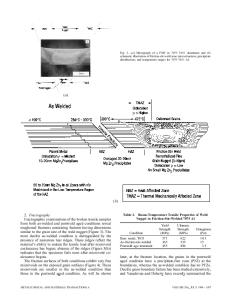Microstructural Characteristics and Mechanical Properties of Friction Stir Welded Thick 5083 Aluminum Alloy
- PDF / 10,421,870 Bytes
- 22 Pages / 593.972 x 792 pts Page_size
- 96 Downloads / 300 Views
T the forefront of the research and development in welding technology, friction stir welding (FSW) is a remarkable and potentially useful welding technique that has been invented and developed in this decade.[1] Recent trials have shown that FSW can be used to join aluminum and its alloys up to 75-mm plate thickness in a single pass, opening up the technology to new applications.[2] This one pass capability can translate into significant cost savings with excellent metallurgical and mechanical property combinations when constructing large aluminum structures such as oil and gas tanks, off-shore platforms, and military parts.[3,4] For thick plates up to a thickness of 100 mm or more, electron beam welding is the preferable fusion welding technique.[5,6] However, the drawbacks of this method are high capital costs, required joint preparation, limited to indoor welding, and requires a vacuum condition for its operation.[7,8] As a solid state joining process, the FSW of thicker aluminum sections is considered to be an alternative process with several metallurgical and MURSHID IMAM, Postdoctoral Researcher, YUFENG SUN and SEIICHIRO TSUTSUMI, Associate Professors, and HIDETOSHI FUJII and HIDEKAZU MURAKAWA, Professors, are with the Joining and Welding Research Institute, Osaka University, Ibaraki 5670047, Japan. Contact e-mail: [email protected] NINSHU MA, Manager, is with JSOL Corporation, Engineering Technology Division, Nishi-ku, Osaka, 550-0001, Japan. Manuscript submitted August 9, 2016. METALLURGICAL AND MATERIALS TRANSACTIONS A
mechanical advantages such as solidification cracking, porosity, distortion, and joint efficiency.[9] In addition, the absence of shielding gas or filler wire, ultraviolet or electromagnetic radiation hazards, lower energy requirements, and higher tolerance to edge preparation are cited as some of the additional key benefits of this process.[10–15] FSW involves a complex physical mechanism inducing an interaction amongst the tool, workpiece, backing plate, and surrounding environment through several simultaneous thermo-mechanical processes which affect the heating and cooling rates, plastic deformation condition, recrystallization phenomena, distributions of second phase particles, precipitates morphology, and structural integrity of the joint.[16,17] Using FSW for joining thicker sections of aluminum alloys is not as advanced and there is little information available in the literature. Compared to the thin weld, the FSW of thick weld requires a higher power, load bearing ability of the tool, axial load, and welding and clamping forces. These requirements for the FSW of thicker sections make the task more challenging in terms of the FSW machine and tool limitations and design. Therefore, the selection of critical process control parameters such as the axial load, tool rotational speed, and welding speed becomes more challenging than the thin welds. In particular, the requirement of higher axial load increases both the hydrostatic pressure beneath the tool shoulder and the temperature within the
Data Loading...











